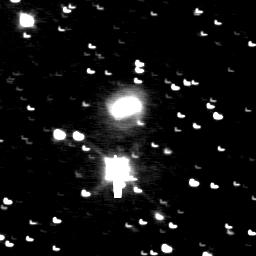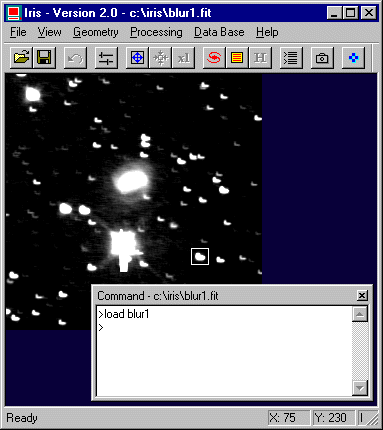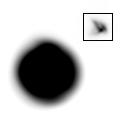
IRIS TUTORIAL
Deconvolution
Iris includes some deconvolution algorithms, for example the Richardson-Lucy algorithm, known to be used for the Hubble Space Telescope. For example apply the RL deconvolution to this severely blurred image (tracking problem):

Define a small rectangle (with the mouse) just around an unsaturated and isolated star. The shape of this star define the so called PSF (or Point Spread Function) of the instrument. The goal of the deconvolution is to sharpen this star and finally, all the image.

A rectangle is defined
around a high signal to noise ratio star, but it is important to select a unsatured
star.
Then, enter the following console command:
>RL 15 0
The first parameter defines the number of iterations to be done. Here Iris execute 15 iterations of the RL algorithm. The second parameter corresponds to the relaxation factor of the algorithm, which is a means to reduce the noise in the final image. If the value is 0, the original Lucy algorithm is used. For a value greater than 0 (typically 1), a relaxation method is used, that will decrease the strength of the algorithm in noisy areas. Note that this algorithm requires a large number of mathematical operations (including several Fourier transforms at each iteration), so process times may be long and memory consuming if the image is large. RL command can only process 16 bits images.
Finaly, suppress some noise and compare with the start image...
>GAUSS2 .7

The result of Richardson-Lucy
deconvolution.
Important considerations:
(1) It is mandatory that the image has a square size and that this size is a power of 2 (ie: 128 x 128 pixels, 256x256 pixels, 512x512 pixels, ...). The WINDOW3 command is very usefull for respect this condition (example: WINDOW3 256 generate a 256x256 pixels image centered around the mouse selected region of the image.
(2) It is also important that the background level is close to 0 (use the OFFSET or NOFFSET commands for example).
Modified version of the Richardson-Lucy deconvolution algorithm exist in the form of RL2 command. The difference with command RL comes from the reduction of granular structure and ringing effect around the bright point-like objects. Just like RL, RL2 command use Fourier transforms and it is recommended to crop the image so that these with dimensions has a size equal to a power of 2 (128, 256, 512 pixels). Use for that WINDOW3 command, especially designed to isolate a squared part of an image. RL2 is used like RL (select with the mouse an unsaturated star before run it). The syntax is: RL2 [ NB ITER ] [ COEF ]
The example below shows an important reduction of both granularity and ringing effects.
|
|
|
|
Iris implement also the Maximum Entropy method, a sophisticated tool.
We want to process a blurred Mars image. The telescope used for that image was not well collimated (!), which resulted in coma and astigmatism. Just after the planet observation, a star was observed close to Mars in the sky. The star image has been added to the Mars image (just using the ADD command) so that it becomes possible to obtain a PSF reference. Draw a rectangle around the star and run the deconvolution MEM:

Note the star added artificially. The image of the star is a long exposure
for fix the atmospheric turbulence.
>LOAD BLUR2
>MEM 12
The argument of MEM command is the number of iteration.
|
|
The result before and after 12 Maximum Entropy iterations.
Here another example:
|
|
And an exemple concerning Jupiter planet observed
in an IR methane band.
|
|
Image of Jupiter in the methane band (7800 A). SL9 impacts are visible in the upper part of the disk. A satellite transit is in the lower part. Red Spot is in the right side limb. A galilean satellite is used for define the PSF. Rigth, 20 iterations of maximum entropy algorithm.
The VanCittert deconvolution algorithm is also available. The implementation of Iris allows a fast processing of the images, effective, but of which it is necessary to moderate the effects also!. Syntax is
VANCITTERT [ FWHM ] [ A NUMBER OF ITERATION ]
In the image to process measure the width of a typical star (the FWHM). For that, to surround a star with a small selection box and run PSF command of the contextual menu. If the noted FWHM is for example of 2.6 pixels, run
>VANCITTERT 2.6 5
Choose the number of calculation loop and judge the effect. The command can also be employed on planetary images.